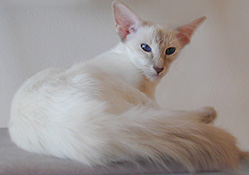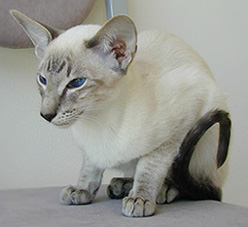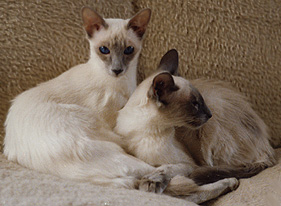

home cattery girls boys news litters articles gallery links
 Balinese are long-haired Siamese (Ch. Aldinia della Luna di Tina)  seal-point Balinese (Am.GC Balijoy Michaelangelo)  Balinese kitten (Livius Verus of blue Moon) 
Siamese Variant blue-tabby-point (Halim-Sha of blue Moon) |
The Balinese is a svelte cat with long, tapering lines and a light but strong
body structure.
Because of its longer fur, the Balinese appears to have softer lines and less
extreme type than the shorthair Siamese. Because of its Siamese history, the Balinese has
deep, vivid
blue
eyes and pointed colors. This means the colour is seen only on the coldest parts of the body. All Balinese and Siamese cats are born white but gradually develope their colour on the face, ears, paws and tail. The rest of the body is lighter. The point colour varies from rather light
to almost black. Today, the Balinese cat can be bred in around 20 different colours and patterns of the points, including the white Balinese without any points. The green-eyed orientals without points are called Oriental Shorthar or Longhairs.
Elegance on four feet The Balinese did not got without reason its name from the graceful dancers in Bali. There is something very special about the graceful and elegant carriage of this cat. The blue eyes and the exquisite coat on the long muscular body adds to the aristocratic expression. The head of the Balinese forms a long, tapering wedge with a long, straight profile. Ears are large and continue the wedge. Eyes are blue and almond shaped. In fact, the Balinese is exactly like a Siamese except for the coat, which is medium in length, fine and silky without a downy undercoat. It lies close to the body, flowing toward the rear where it ends in a graceful, plumed tail. Affection personified on four feet If you decide to buy a Balinese you should consider that you will get a new member of your family. A Balinese is affection personified on four feet. Especially if they are kept alone they get extremely attached to "their person". A Balinese loves you, and you must be informed about this at frequent intervals. When you sit down, he sits, too - on or beside you! When you go to bed, so does he, - and if you allow - of course on top of your cover, or under them, pressed like a plaster to your back or side. This way you being sung to sleep to the tune of his thunderous purr of satisfaction. This is why for many people "once an oriental cat, means always a an oriental cat". It does not matter which of the 4 oriental breeds (Siamese, Balinese, Oriental short- and longhairs) you take, the temper is more or less the same. Intelligent, Communicative and Full of Temper Siamese and Balinese cats are regarded as one of the most intelligent cats. They learn extremely quick, are curious about almost everything and you can be sure that they always have new ideas how to get your attention. They are full of temper and love to play their whole life. Often they fetch toys like a dog when thrown and make excellent playmates for children. All oriental cats are very "communicative" and love to "speak" with their owners. Especially if you come home and a pair of sparkling blue eyes is awaiting you at the door, there is always a lot of things to tell. During the years you will learn the meaning of the many different sounds they can make. How to keep them Balinese are easy to care for, because they have a single silky coat that lies close to the body. All that is needed is an occasional brush or comb and routine nail clipping. A good diet and plenty of exercise are essential to maintain the Bali's firm, tubular body and silky coat. Balinese and Siamese love to live in groups, and if you have a couple or more orientals, they will often share their whole life in close friendship. Especially if their owner is not at home, you will often found them sleeping entwined around each other. It is always recommendable to keep at least 2 of these affectional cats together. They are generally very good natured, mixing also very well with other breeds or even other pets, and are content to live indoors, if they are used to it and get enough attention. Variants Short-haired Balinese and Oriental longhairs, known as Variants, may also be seen as breeders have constantly bred back to top quality Siamese and Oriental short-hairs to improve the type and eye color of Balinese and Javanese. They have a short plush coat and are invaluable in a Balinese or Javanese breeding program. |
|
History The story of the Balinese begins in the United States in the mid-1950s. Legend has it that breeders were intrigued by long-haired kittens appearing from time to time in litters of Siamese. These kittens were Siamese in type but had longer, silky hair and when mated were found to breed true. However, it is also possible that the long-haired gene was introduced when newer colors were created in Siamese by out-crossing to Turkish Angoras or other long- haired cats. A few breeders in the United States were so charmed by these long-haired Siamese that they determined to establish them as a breed and to work towards recognition by the American associations. Pioneer breeders were Mrs Marian Dorsey of California (Rai-Mar prefix) and Mrs Helen Smith of New York (Merry Mews prefix), with Mrs Sylvia Holland, an Englishwoman living in California, most closely associated with the development of the breed under her famous "Holland's Farm" prefix. Mrs Smith was responsible for the name "Balinese", when she remarked how akin they were to "exotic Balinese dancers" - unfortunately one cannot visit Bali and expect to find an indigenous population of Balinese cats. So by the late 1950s the breed had a name and had been placed on the Foreign Long Hair division of the Cat Fanciers' Federation. Over the years, cat fanciers associations all over the world have reconised them. They have grown in popularity to such an extent that apart from the traditional colors: seal-, blue-, chocolate- and lilac-point, in many countries they have also recognised foreign white, red-, cream-, tabby- and tortie-pointed Balinese. Moreover, Balinese breeders started also to breed Oriental Longhairs in all kind of colours and patterns. Since the early days, the look of the Balinese cats has changed quite dramatically due to outcrossing with their Siamese cousins to achieve a true "long-haired Siamese". The Balinese cats seen today are the result of much time and effort by a dedicated band of hard working breeders. |  2 US Balinese in the early 90es,
|